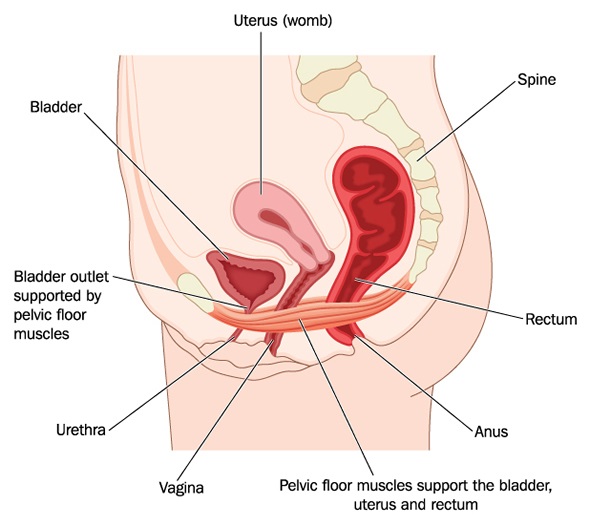Pelvic floor muscles stretch from the tailbone to the pubic bone and are used to support the bowel, bladder, uterus and vagina. Weak pelvic floor refers to when these muscles are not as strong as they should be, resulting in several consequences such as urinary or bowel incontinence.
Women are much more susceptible to weak pelvic floor, which is likely to be associated with female-specific causes of the condition such as pregnancy, childbirth and post-menopause, in addition to the female anatomy of the pelvic region.

Image Copyright: Shutterstock.com / User:Blamb
Causes
Weakening of the pelvic floor can occur for a variety of reasons including:
- Pregnancy – weight of the uterus
- Childbirth – stretching of vaginal muscles
- Post-menopause – lower level of estrogen hormone
- Obesity – weight on the pelvic region
- Constipation – straining to pass motions
- Coughing – straining of pelvic muscles
In addition to these, age is a strong risk factor for a weak pelvic floor. This may be due to hormonal changes in women after menopause or general loss of muscle tone as a part of the normal aging process.
Symptoms and Complications
Individuals with weak pelvic floor muscles may experience symptoms including:
- Leaking urine when coughing, sneezing, laughing or running
- Failing to access a bathroom in time to urinate
- Breaking wind when bending over
- Reduced sensation of the vagina and swelling at the opening
- Dislodgement of tampons from inside the vagina
- Backache
These symptoms may also affect other areas of an individual’s life. It is common for people to experience difficulty with sexual encounters, due to the importance of the pelvic floor when engaging in sexual activity.
Losing control of the bladder and bowels are also widespread issues, which carry heavy social outcomes. It can be difficult and embarrassing for individuals to interact with others normally due to the fear that they might lose control of their pelvic floor. This has the potential to lead to social isolation and depression.
Prevention and Management
The best course of action to prevent or treat weak pelvic floor is to use certain exercises to improve the strength of the muscles.
These exercises, called pelvic floor exercises or kegel exercises, are specifically designed to help individuals to identify and regain control over the pelvic floor muscles. They involve tensing of the muscles in the area and then relaxing, repeated several times in each session. Completed frequently, kegel exercises are the preferred management option to strengthen the pelvic floor.
It is also important to consider the cause of the condition. Someone who is overweight may benefit from weight loss; whereas eating more fiber, fruit and vegetable may help someone who experiences frequent constipation. If a chronic cough may be the cause, medical attention to address this may be warranted.
References
- http://www.betterhealth.vic.gov.au/bhcv2/bhcpdf.nsf/ByPDF/Pelvic_floor/$File/Pelvic_floor.pdf
- http://c.ymcdn.com/sites/www.iuga.org/resource/resmgr/brochures/eng_pfe.pdf
- https://www.thewomens.org.au/health-information/pregnancy-and-birth/a-healthy-pregnancy/the-pelvic-floor/
- http://www.pelvichealthsolutions.ca/for-the-patient/pelvic-floor-muscle-weakness/
Further Reading
- All Pelvic Floor Content
- Pelvic Floor Muscles
- Kegel / Pelvic Floor Exercise
Last Updated: Jun 28, 2019

Written by
Yolanda Smith
Yolanda graduated with a Bachelor of Pharmacy at the University of South Australia and has experience working in both Australia and Italy. She is passionate about how medicine, diet and lifestyle affect our health and enjoys helping people understand this. In her spare time she loves to explore the world and learn about new cultures and languages.
Source: Read Full Article



